Journal of
eISSN: 2574-9943


Case Series Volume 7 Issue 4
1Departament of Dermatology, University of Mogi das Cruzes, Mogi das Cruzes - SP, Brazil
2Departament of Plastic Surgery, Federal University of São Paulo – São Paulo - SP, Brazil
3Departament of Dermatology, University of the State of Rio de Janeiro, Rio de Janeiro - RJ, Brazil
4Departament of Dermatology, University of ABC, Santo André - SP, Brazil
Correspondence: Luciana Gasques, Departament of Dermatology, University of Mogi das Cruzes, Mogi das Cruzes – SP, Brazil, Av. São Sebastião 3125, sala 501; 78045-000 Cuiabá – MT, Brazil, Tel +55-65-98150-3366
Received: November 29, 2023 | Published: December 14, 2023
Citation: Gasques L, Gonzaga AL, Giraldelli G, et al. Face contour treatment with Radiesse +: A new technique. J Dermat Cosmetol. 2023;7(4):148-152. DOI: 10.15406/jdc.2023.07.00252
With facial aging, lower face suffers gravitational changes due to loss of skin elasticity and bone and cartilaginous tissues remodeling. If skin excess and sagging is not high enough to justify the surgical approach, the intervention with calcium hydroxyapatite is justifiable. The article describes a technique using calcium hydroxyapatite with lidocaine (CaHA; Radiesse+, Merz North America, Inc., Raleigh, NC, USA) injection in mandibula and chin to restore facial contour that was lost in aging. This case series included men and women who underwent Radiesse+ injection in the mandible and chin at a private clinic from June 2019 to January 2022. The sagging tissues in the jowls were repositioned, starting from an access in the jowl, with vectors directed to the mandible angle and chin. The product was deposited in the subcutaneous flat, in the form of a bolus and retro injection, along the mandible and chin region. The volume of product initially used was individualized based on individual needs, but due to local edema caused on the first day, patients were reassessed after 7-15 days, in order to obtain a satisfactory result, if necessary, more volume was applied.
Results: Eighty-six patients were included. Mean scores on the Global Aesthetic Improvement Scale taken by patients 3 months after treatment indicated "much improved". The procedure was well tolerated, with no adverse events. Restoring facial contour with collagen stimulation using a biostimulator such as Radiesse+, allows a natural and lasting result with a high degree of patient’s satisfaction and few adverse events.
Keywords: facial contour, calcium hydroxyapatite, Radiesse+
CaHA; calcium hydroxyapatite
Since ancient Egypt, beauty standard was defined by Nefertiti Queen with a thin face and elongated neck, with a marked line of contour. With facial aging some aspects change in the face anatomy: in lower face, the gradual and progressive tissue’s ptosis results in enlargement of the chin, effacement of mandible’s angle and loss of face contour, resulting in a square face and shorter neck. This lower face suffers gravitational changes due to loss of skin elasticity and bone and cartilaginous tissues remodeling.1–2
In recent years, the focus in esthetic medicine has moved from surgical toward nonsurgical procedures, at the same time as treatment options and indications have expanded, and consumer awareness has increased. Jawline contour restoration is an example of this trend.3–5
If skin excess and sagging is not high enough to justify the surgical approach, minimally invasive option in the form of calcium hydroxyapatite is available to create a straight and youthful jawline. Calcium hydroxyapatite is effective and safe, and because it has a high G prime, it can be used to improve the restructuring of facial compartments, maintaining the three-dimensional structure, repositioning ligaments, fat pads and preventing bone resorption. In addition, it has a great ability to stimulate collagen, improving skin quality in the long term. Therefore, in addition to harmonizing the face, restoring volume, it also improves the quality and firmness of the skin, stimulating collagen production.6–8
A youthful jawline is characterized by a straight line from the chin to the mandibular angle, but later in life, it is often masked by the classic signs of lower-face aging, which include jowling, the appearance of prejowl sulcus and marionette lines. With time, the contour of the lower face becomes squarer than oval, as clearly illustrated by the Merz Aesthetics Scale by the Merz Aesthetics Scale (Merz Pharmaceuticals GmbH, Frankfurt, Germany) for the jawline.9 The scale quantifies the evolution of facial aging using a simple five-point photo numeric rating and can facilitate discussion between subjects and physicians as well as being of value in clinical research.10
We report an application technique using calcium hydroxyapatite with lidocaine (Radiesse+) for the treatment of the mandible and chin, restoring the facial contours of 86 patients.
Study design and population
This study took place in a private practice between June 2019 and January 2022. Eighty-six (n=86) patients, Woman (n=60) and men (n=26), with mild, moderate and severe sagging (manifested by presence of accumulation of fat in the jowl and loss of mandibular contour), aged 40-70 years, whose body mass index (BMI) was less than 30 were selected to the study group. Each signed an informed consent form of the risks and allowing us to use photographs. Subjects were excluded if they had undergone cosmetic procedures in the face and neck in the previous 6 months, had scars or infections in the target area, significant facial asymmetry, were receiving anticoagulants or immunosuppressive treatment, had autoimmune diseases, history of massive weight loss or those who were pregnant or breastfeeding and patients with unrealistic expectations. The study was approved by the Research Ethics Committees (CAAE: 67937323.6.0000.5249). Patients were informed about the study treatment protocol and signed a consent form authorizing the use of data and images for scientific purposes. This study was conducted in accordance with the ethical principles of the 1975 Declaration of Helsinki and is consistent with Good Clinical Practice principles. Standardized photographs were taken before, post immediately each session and at 3 months following treatment. Outcome was assessed by the patients using a validated Global Aesthetic Improvement Scale. Adverse outcomes were documented.
Marking:
Initially, the jowl fat pad is marked as the place where the product won’t be applied. In this place, an anesthesic button is made to introduce the cannula (Figure 1).
By palpation, a horizontal line is marked in mandible posteriorly, up to its angle and another line, from this one, transversely toward the tragus. So as the anterior limit of the jowl to the lower tip of the chin bone (Figure 2).
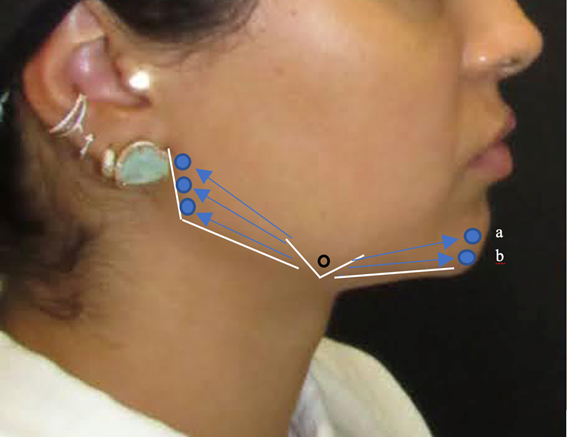
Figure 2 Illustration of jowl and mandible markings (white lines). Point of the anesthetic button through which the cannula will be introduced (black circle), contained within the jowl, where we will not apply the product. Bolus product placement points (blue balls) and retro injection sites (blue arrows). In the chin, point "a" promotes projection of the chin, while point "b" stretches the chin.
It is important to differentiate chin’s marking in men and women. Women’s chin should be more tapered. Therefore, a lower line is drawn from the outer corners of the nostrils and cupid’s bows. Chin treatment must be within these marking to avoid square and masculinization of the female face (Figure 3).
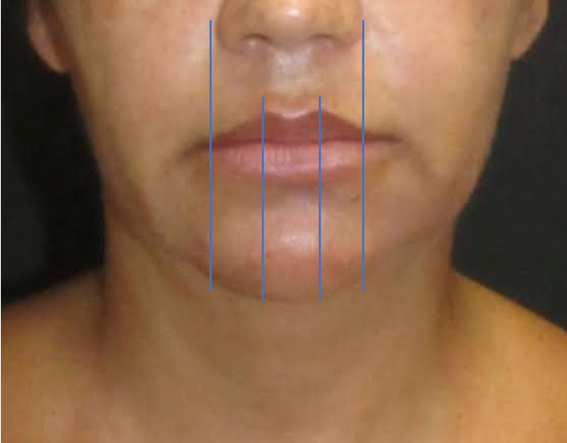
Figure 3 Chin marking in women: lateral points from the side of nasal wing and medial points from Cupid ’s bow.
On the other hand, men`s chin must be square. Therefore, marking is made on lateral margin of the lips and the internal marking on lateral corners of nasal wings. Volume should be applied at this point (Figure 4).
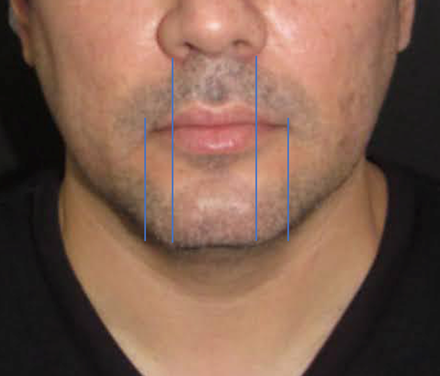
Figure 4 Chin marking in men: lateral points from the outer’s corners of the lip and medial points from the outer corner of nasal wings.
Furthermore, chin is divided longitudinally in three parts. Lengthening is performed in lower third and its projection in middle third. Male chin shouldn`t be too elongated and female chin shouldn`t be too projected (Figure 5).
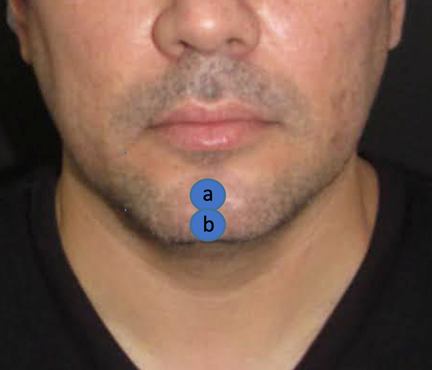
Figure 5 Chin`s longitudinal marking: the chin is divided into three equal parts. Product injection in the median mark (a) promotes chin`s projection. Product injection at the lower mark (b) promotes chin`s elongation.
Technique:
Cannula must be introduced into the anesthetized point in the jowl. Then, it is posteriorly angled towards the marking of mandible`s angle. There 0,1ml in bolus are inserted, following 0.2ml in retro injection with the limit at jowl`s posterior edge. Again, the cannula is inserted superiorly and another 0.1ml bolus and 0.2ml retro injection is injected, forming a triangle with previous application. Repeat the same technique on the other side.
Then, from the same introduction point of the cannula, it is angled anteriorly, towards the chin. To lengthen the face, it goes to the inferior medial point of the chin. To project the chin, to the medial midpoint. There 0.2ml is injected in bolus and 0.3ml in retro injection until the anterior point of the jowl. The amount of volume for a beautiful result can vary depending on individual needs. It is important that the injector, after applying the initial volume, reassess the patient and, if necessary, reapply more volume.
In the first session, an average of 1-2 syringes was performed, due to the tissue edema that occurs immediately after application, the evaluation of the result can be difficult. Therefore, reassessment and application of more volume may be necessary after the edema has subsided. Reassessment is suggested between 7-15 days from initial application. The maximum total volume performed in some patients was 6 ml (4 syringes), with good tolerability and customer satisfaction.11
There were 86 patients treated with this technique in two and a half years. The improvement in facial contour was immediate with restoration of the angle of the mandible, reduction of excess skin in the anterior cervical region and reduction of jowl ptosis. Due to the immediate tissue edema, there was a need for re-approach and reinjection of more volume in most patients after a few days. Patients rated improvement using the Global Aesthetic Improvement Scale, graded in 4 stages, where 1 = “Worse” - no improvement, 2 = “Mildly improved” < 25% improvement, 3 = “Improved” - 25-49% improvement, and 4 = “Much improved” - > 50-75% improvement. All patients rated improvement 4, with great satisfaction. Patients continue to be followed up, with sustained satisfactory results. (Figure 6 - Figure 12).
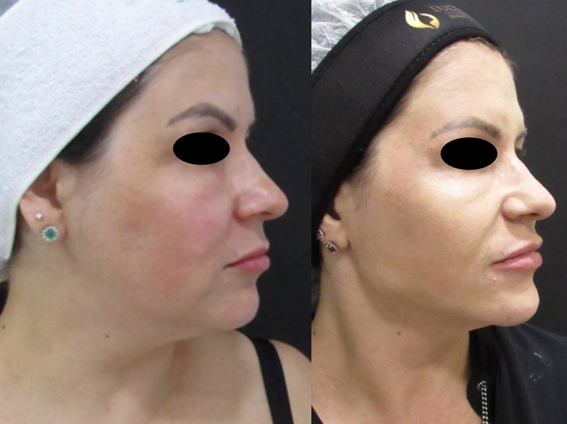
Figure 6 Patient 1. Result after two approaches with a total volume application of 4.5ml of Calcium Hydroxyapatite (3 Radiesse+ Syringes).
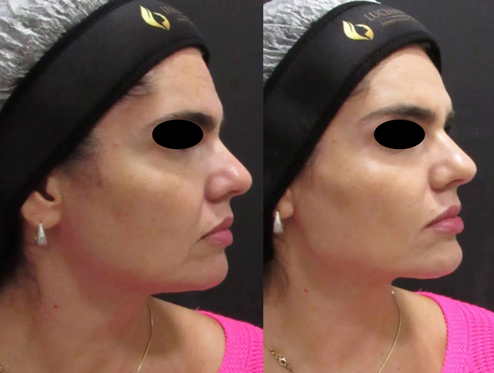
Figure 7 Patient 2. Result after one approach with a total volume application of 1,5ml of Calcium Hydroxyapatite (1 Radiesse+ Syringe).
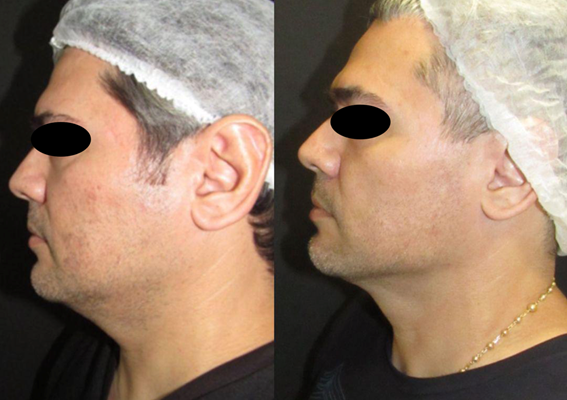
Figure 8 Patient 3. Result after two approaches with a total volume application of 6.0 ml of Calcium Hydroxyapatite (4 Radiesse+ Syringes). Three months follow up.

Figure 9 Patient 4. Result after two approaches with a total volume application of 6.0 ml of Calcium Hydroxyapatite (4 Radiesse+ Syringes).
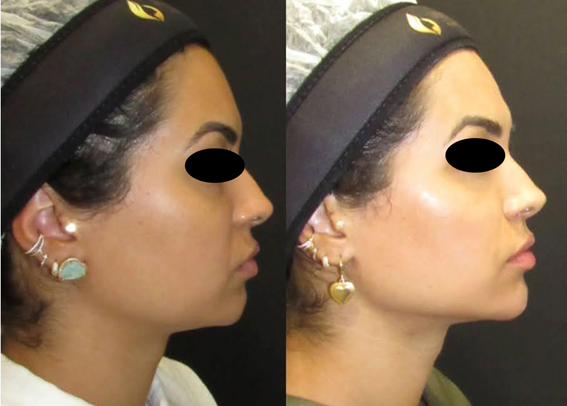
Figure 10 Patient 5. Result after one approach with a total volume application of 1.5ml of Calcium Hydroxyapatite (1 Radiesse+ Syringe).
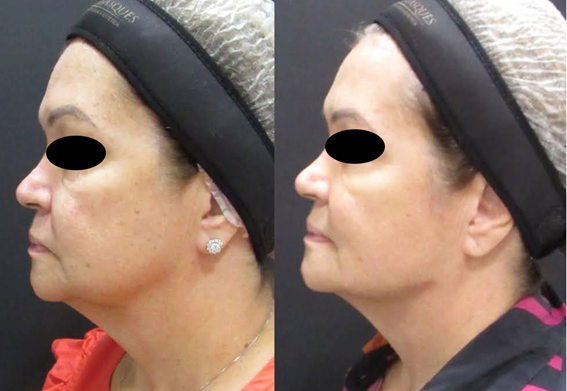
Figure 11 Patient 6. Result after two approaches with a total volume application of 3.0 ml of Calcium Hydroxyapatite (2 Radiesse+ Syringes).
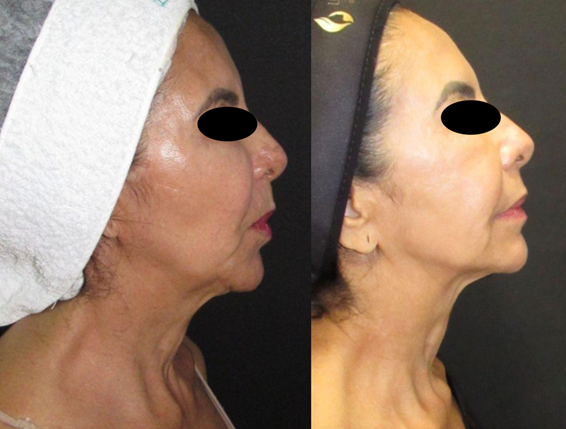
Figure 12 Patient 7. Result after two approaches with a total volume application of 3.0 ml of Calcium Hydroxyapatite (2 Radiesse+ Syringes). Six months follow up.
Complications
Most common complication was transient swelling, which had an important improve between 2-5 days spontaneously, without the need for intervention. Another common complication was hematoma that can happens at the entry point of the cannula and at the chin, due to tissue expansion. It must be managed with local compression at the time of its formation and, later, with warm compress and arnica cream. Pain at the application site may also occur and can be treated with pain relievers. One patient evolved with blister formation due to lymphatic drainage difficulties. It happened due to injection of a large amount of volume in a single application, which also had spontaneous remission in 5 days (Figure 13).
In 2009, the FDA approved a protocol that added lidocaine to the compound with CaHA for greater comfort during application. Since 2016, the CaHA implant already added to lidocaine has become a formulation available for use in Europe.2 With the addition of lidocaine to CaHA, clinicians have greater flexibility in their treatment techniques and injection sites, and benefit from decreased patient discomfort.12 This product called Radiesse + contains 30% calcium hydroxyapatite, 70% gel as a vehicle by volume and lidocaine hydrochloride 0.3 % in its formulation. Being totally biodegradable, subdermal and deep application.
The G' measurement of the calcium hydroxyapatite product is high when compared to other hyaluronic acid fillers. Therefore, it is interesting to use it in places where we want greater projection, such as the malar region and also to define the jaw line, and also build vectors with the behavior of real columns that, implanted in the depth of the skin, fill, volumize, but mainly, support the skin. In addition, when injected subcutaneously, calcium hydroxyapatite stimulates the production of collagen III and then collagen I, which improves skin tone and quality.
Products with hyaluronic acid used as fillers are effective and safe, but have low potential to stimulate tissue collagen. Calcium hydroxyapatite is also effective and safe, in addition to having a great ability to stimulate collagen. Therefore, in addition to harmonizing the face, it also improves the quality of the skin.
When we want to harmonize an individual's face, we can use Radiesse + promoting projection in some points and volumization in others and, in addition, we can dilute the product and apply it on a more superficial plane to stimulate collagen even more and improve the quality of the skin.13–15
In this prospective, observational study, treatment with CaHA was associated with a clinically significant improvement in jawline contour. The results were immediately visible, and the improvement remained significant after the initial treatment. The facial lower third suffers from loss of contour and tissue ptosis during the process of aging and its treatment is a very important point in beautification of the face. Restoring facial contour with collagen stimulation using a biostimulator such as Radiesse+, allows a natural and lasting result with a high degree of patient’s satisfaction.
None.
The authors declare there is no conflicts interest.

©2023 Gasques, et al. This is an open access article distributed under the terms of the, which permits unrestricted use, distribution, and build upon your work non-commercially.
 May is recognized as Skin Cancer and Melanoma Awareness Month. It’s time for us to speak up about the dangers of skin cancer, share the facts about sun protection and early diagnostics to help save lives. This year the motto of Skin Cancer Awareness Month is “Slip-Slop-Slap”. For this event Journal of Dermatology & Cosmetology is welcoming all the submissions to share the importance of protecting the skin exposure to UV radiations and the articles received for this month will be offered with 40% discount on publication.
May is recognized as Skin Cancer and Melanoma Awareness Month. It’s time for us to speak up about the dangers of skin cancer, share the facts about sun protection and early diagnostics to help save lives. This year the motto of Skin Cancer Awareness Month is “Slip-Slop-Slap”. For this event Journal of Dermatology & Cosmetology is welcoming all the submissions to share the importance of protecting the skin exposure to UV radiations and the articles received for this month will be offered with 40% discount on publication.